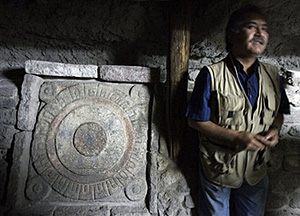 |
 |
 |
 News Around the Republic of Mexico | March 2007 News Around the Republic of Mexico | March 2007  
Mexico Opens Windows on Buried Treasures
 Mark Stevenson - Associated Press Mark Stevenson - Associated Press


| | Mexican archaeologist Eladio Terreros, right, talks to reporters next to an Aztec image called a 'quincunce,' during a tour of underground sites below the Metropolitan Cathedral in Mexico City, Friday, March 30, 2007. (AP/Gregory Bull) |
Archaeologists in Mexico City announced plans Friday to hold tours of inaccessible buried ruins via glass-covered shafts looking down on the sites.

Two daylong guided tours of the sites, known as "archaeological windows," are scheduled for April, and will take visitors to about 20 sites currently open to the public, as well as 20 more "windows" hidden beneath stairwells, floors and patios of buildings normally not open to the public.

The underground ruins — some swallowed or encased by the foundations of the Spanish buildings constructed atop them following the 1521 conquest — cannot be fully excavated without destroying the crumbling colonial buildings above them.

Moreover, the city's sinking subsoil — the result of excessive water extraction — caused buildings to sink. Seeking a solid foundation above the water table, later generations demolished the buildings and used the rubble to fill in the sinking lot, preserving subterranean layers of temples, floors, walls, stairways, convents and patios.

Among the stranger sites shown in an initial tour for reporters is an Aztec stone discovered about three decades ago beneath the city's cathedral. The stone depicts a symbolic connection between heaven, Earth and the underworld.

However, archaeologist Eladio Terreros, head of the program for the National Institute of Anthropology, said the Aztecs did not see the underworld as "hell." While the Aztecs tied the underworld to death, they also saw death as bringing forth life, Terreros said. He added the stone has no relation to the Roman Catholic cathedral above, which dates to 1567.

Human skulls are visibly entombed in a wall of the predecessor of the city's cathedral, a smaller building built in the early 1500s that is now buried under the current church.

The origins of the archaeological window technique go back to the early 1900s, when archaeologists began burrowing down to Aztec temples without disturbing the Baroque structures above them. By the 1960s, as subway lines were sunk through the downtown area, Aztec temples began turning up — and being preserved — even in subway stations.

"We save what we can, and we leave other things buried," Terreros said. | 
 | |
 |



